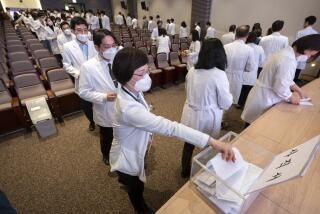S. Koreans Seek Healing for Wounds They Say Americans Inflicted in War
HAMAN, South Korea — Tears streamed down Hwang Kae Il’s face as the 56-year-old farmer recalled the day in 1950 when an American fighter plane attacked him and hundreds of fellow refugees, killing his father and many of his neighbors.
These weren’t tears of grief, however, shed decades after the Korean War. A bullet from the aircraft’s machine guns passed through his father’s neck before smashing Hwang’s cheekbone and tearing out his left eye. The endless flow of tears is a constant reminder, Hwang said, of the injustice he and his neighbors suffered.
“I’ve carried this with me almost my entire life,” he said.
Hwang is among dozens of South Koreans who have come forward in recent months to demand that the U.S. government accept full responsibility and compensate them for what they label systematic war crimes.
Last month, President Clinton expressed regret to victims and their families for an incident in the South Korean hamlet of No Gun Ri, where U.S. troops in July 1950 fired on civilians cowering under a railroad bridge, killing an undetermined number. A U.S. report compiled after 15 months of research and interviews found no evidence that the soldiers were ordered to shoot. Washington hopes that its response resolves this highly emotional bilateral issue.
“I deeply regret that Korean civilians lost their lives at No Gun Ri,” Clinton said about a week before he left office.
However, residents of Haman and neighboring villages who gathered at a community center recently to plot strategy and discuss their years of silent suffering said Clinton’s statement was small consolation.
Shim Sang Hyon, a 72-year-old farmer from neighboring Pochon village, recounted with great anger how he lost his bride on Aug. 11, 1950, when four U.S. aircraft flew low and dropped incendiary bombs on his isolated community. “It was chaos, just what I imagine hell is like,” he said.
Kim Ie Myong, 74, rolled up her flowered pants to display her crippled shinbone, pierced and split by a bullet as she carried a child strapped on her back. She remains upbeat despite her many years as a disabled mother. “Just think how much more cheerful I would be without these injuries,” she said.
And Hwang Young Jae, 59 and no relation to the farmer, recalled his mother’s death in August 1950 as she breast-fed his 2-year-old sister. “There was so much blood everywhere that dogs were coming over and drinking it,” he said.
They brought X-rays showing their bones and skulls still filled with shrapnel, and carried rocks they said were dirt fused together by the gunfire, even as they complained that investigators have not been interested enough to corroborate their claims.
Many of the alleged victims are concentrated in this vegetable- and rice-growing area nearly 200 miles southeast of Seoul, where some of the war’s most intense fighting occurred. As North Korean soldiers swept south in the summer of 1950 and nearly drove the allied troops into the sea, U.S. forces finally halted the enemy advance here and elsewhere near the peninsula’s southern shore. Locals say nearby Yohang mountain changed hands 19 times, prompting U.S. soldiers to give it a new name: “that goddamned mountain.”
Many area residents say their first instinct as hostilities spread was to hide. But South Korean police told them to gather in a large field in the shadow of Yohang mountain wearing white, so they would be more easily identified as noncombatants friendly to the south. In fact, many villagers contend, such advice made it easier for U.S. fighters and bombers to strike them over a several-week period that August.
The farmers say they remained quiet for so many years because to do otherwise would have been suicidal. As the Cold War intensified and a series of strongmen ruled South Korea, they say, police did everything possible to shut them up in order to avoid upsetting relations with the United States.
Even mentioning how they were injured was a treasonable act, they claim, adding that “troublemakers” who talked were taken away. Korean social conventions also played a part: Even now, more than 50 years later, many women who allege that they were repeatedly raped by U.S. soldiers are too ashamed to speak out for fear they will be shunned.
Clinton’s Statement Seen as Whitewash
Residents say they appreciate the regret expressed by Clinton for the No Gun Ri attack, which was brought to light in 1999 by Associated Press. But they ultimately believe that the statement was a whitewash designed to dampen anti-Americanism in South Korea.
To raise awareness of their cases, farmers here, along with student and citizens groups, are watching closely the compensation cases that No Gun Ri victims are bringing in U.S. civil courts.
They also plan to meet with European officials on the issue later this month, bring their case before the U.N. Human Rights Commission in Geneva in March and hold a mock war tribunal in New York in June.
Although passions run deep in Haman, with its scratchy farms and country darkness, residents will ultimately need to gain the support of middle-class city dwellers to prevent their cases from slipping back into obscurity. But the Korean media have dropped the issue in recent weeks, suggesting that Washington’s report could serve as a bookend to these ugly historical episodes. “The case was closed, at least for now,” one editorial said.
South Korean officials cite the political and logistical difficulties in opening each of these cases, and many analysts say it’s time to move on. “The majority of Koreans accept that the report is a closing chapter,” said Chung In Moon, a political science professor at Yonsei University. “Clinton’s remarks were more than we expected.”
A random sampling of ordinary citizens in Seoul, however, suggests that feelings still run deep. Several said the alleged killings, rapes and assaults suffered at the hands of U.S. soldiers cry out for a full airing so South Korea can recover its national dignity.
“If these murders had happened to Americans, the United States would be in an uproar,” said Kim Jin Ho, a 50-year-old businessman. “A full investigation is essential. Compensation is a different matter--Koreans won’t be so concerned if there’s no payment.”
U.S. officials in Seoul declined to comment other than to say that Clinton’s statement was carefully crafted and represented the final word on the issue.
For many outsiders, the idea that the U.S. military would order troops to fire on unarmed civilians seems implausible. U.S. investigators spent considerable time exploring this highly emotional issue before concluding that the shootings were the acts of individual panicked soldiers.
Residents of Haman disagree and cite a strong organizational motivation that was also played out later in Vietnam: the desire to wipe out locals they feared might be protecting enemy infiltrators. No matter that many say they never saw a North Korean soldier before, during or after the alleged U.S. bullets and bombs rained down.
“We are thankful the Americans came to our aid. and we don’t forget that,” said Shim, the farmer from Pochon. “But our village was not enemy territory. And in the end, it was the Americans that killed us, not the North Koreans.”
Even if there were no explicit orders to kill civilians, the U.S. military should take the blame, said Chung Yeon Wook, director of the Seoul-based National Alliance for Democracy and Reunification of Korea, a citizens group.
“It’s highly possible that individual soldiers acted out of their own fear; war, after all, drives people to do irrational things,” Chung said. “[But] it’s still the commanders’ responsibility to oversee their troops.”
Victim’s Wounds Will Never Heal
Whatever the truth, Hwang Kae Il and his neighbors have paid dearly. For most of his childhood, Hwang said, he was ostracized because of his ghastly face wounds. When he was 17, his family sold a rice paddy to pay for crude surgery. But his constantly tearing eye and battered face scared away women and employers, forcing him to get by on a series of odd jobs.
Finally, a few years ago, he met a woman who is also disabled. They married and started a family. But his physical and emotional wounds will never heal.
“In some ways people like Hwang got it the very worst,” said Ahn Sang Bo, chairman of the Haman area victims committee. “He was ostracized from Korean society, treated like a criminal by Korean authorities and forced to spend everything he had on medicine.”
*
Researcher Chi Jung Nam of The Times’ Seoul Bureau contributed to this report.
More to Read
Sign up for Essential California
The most important California stories and recommendations in your inbox every morning.
You may occasionally receive promotional content from the Los Angeles Times.










